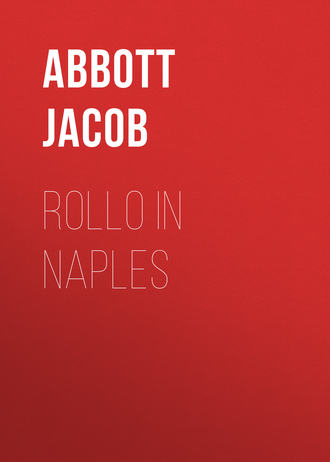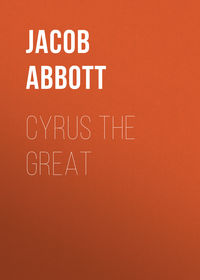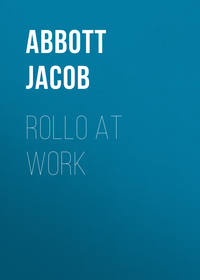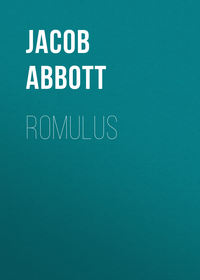
Rollo in Naples
At this moment Rollo saw Mr. George and the two students coming in at the door. The three gentlemen deposited their canes at the little office just as Mrs. Gray had done with her parasol, and then the whole party advanced into the great hall.
Mr. George and the students went with Mrs. Gray and the children into the first room, but they soon left them, and after that Rollo was the sole guide.
Each department of the museum was contained in a separate suit of apartments, at the entrance to which, as I have already said, there was a small iron gate across the doorway. This little gate was kept shut and locked; but there was a man who stood by it, inside, always ready to open it whenever he saw any visitors coming. He always shut and locked the door again when the visitors went in. Then, finally, when they were ready to come out, he unlocked the gate for them, and it was then that they were expected to pay the fee for visiting that part of the museum. Rollo had taken care to inquire about this beforehand, and he had provided himself with a sufficient number of pieces of money of the right value, so as not to have any trouble in making change.
In most of the rooms there were men who had pictures for sale, illustrating the objects contained there, for visitors to buy, in order to carry them home as souvenirs of their visit, and to show to their friends at home. Mrs. Gray bought quite a number of these pictures, and Rollo himself bought several.
The rooms that interested the young persons most were those which contained the tools and household implements, and the various utensils found at Pompeii. In general these things were much more similar to the corresponding articles of the present day than one would have expected to find. But yet there were many differences, both of form and structure, which made them extremely curious to see.
For instance, there was a bell found in one of the houses; but instead of being hollow, and having a clapper inside, as is the custom at the present day, it consisted simply of a large, flat ring, like a plate, with a hole through the centre of it. This ring was hung up by means of a short chain, and by the side of it there was hung a sort of hammer. To ring the bell it was necessary to strike it with this hammer. An attendant in the room did this while Mrs. Gray and Rollo were there, to let them hear how the bell sounded.
"It sounds very well indeed," said Rollo.
"Yes," replied Rosie; "but I don't think it is quite so musical as one of our bells."
There were several pairs of steelyards in the room, too, which were very much like the steelyards of the present day, only they were made of a more ornamental form. The weights were quite pretty little pieces of sculpture and statuary.
There were some very curious and pretty little cooking fireplaces, one of which, in particular, the young people admired very much indeed. Rosie said that she should have liked it very much herself, when she was a child, to play with. In the centre was a sort of pan for the coals, or embers, and all around was a raised border, made double, with a space between to contain water. In one corner there was a raised part, with an opening to pour in the water, and in front, below, there was a small faucet for the purpose of drawing the water out. Of course the embers or coals in the centre of the pan kept the water in the reservoir around it always warm.
There was also a little place on one side where a kettle or a saucepan could stand on two supports, with an opening below to put the coals under.
A great many of the floors in Pompeii were found to be in mosaic; that is, they were formed of various colored stones, arranged together in a sort of bed of cement, in such a manner as to show a picture, or some other ornamental design. In many cases there were only two kinds of stones used, black and white; and these were arranged so as to form borders, scrolls, and pattern work,—as it is called,—of various kinds. In some places a border was formed around the room, and the figure of some animal was placed in the centre. In other cases groups of animals, or of men, were represented, in a very perfect manner. It has always been considered wonderful that such spirited and beautiful designs could be so well represented by a method apparently so rude as the arrangement on a floor of bits of different colored stones.
The best of these mosaics were taken up and removed to the museum. You would think at first that it would be impossible to remove them in any other way than by taking them all to pieces and putting them together again, each little stone in its proper place, on the floor of the museum, where the mosaic was intended to go. But the artists contrived a way to take them up without all this labor, and thus several of the best ones have been removed without disturbing the arrangement of the stones, and have been laid down on the floors of the museum.
One of the most curious of these mosaics is a representation of a dog, which was placed just within the entrance of a house, and just at the entrance were the words, also in mosaic, Cave canem, which is the Latin for look out for the dog. On the preceding page is a representation of this mosaic.
This mosaic was curious rather than wonderful; but in another house there was one which has always been considered a most marvellous production, on account of the complicated character of the design, and the immense number of stones composing it. It represents a battle scene, and contains a great number of men and horses, all mingled together in great confusion on the field of battle. The number of pieces of stone used in making this mosaic is almost incalculable.
Although it was originally made as part of a floor, it is now very carefully guarded, and no one is allowed to walk upon it. It is surrounded by a railing, and along one side of it there is a raised platform for visitors to stand upon in order to see it to advantage.
There were one or two large rooms that were filled with beautifully-formed jars and vases, of a brownish color, and ornamented upon the outside with figures and devices of all kinds. These devices represented all sorts of scenes, and they are considered extremely valuable on account of the light they throw on the manners and customs, and the modes of life, which prevailed in those ancient days. Some of these vases are of very great value. They are very large, and to enable the visitor to see them on all sides, without danger of breaking them, a great many of them are mounted in the museum on stands fitted with a revolving top, so that they can be turned round, and made to present all the sides successively to the spectator. In addition to this, some of the finest specimens are protected by a large glass bell placed over them.
Mrs. Gray and the children found Mr. George and the two students in this room, when they first came into it. Mr. George said that they were going to stay there nearly all that day. They wished to examine the drawings on the vases in detail. Rollo looked at a few of them, but he could not understand them very well.
"You will understand them better," said Mr. George, "when you have learned more about the ancient mythology."
"But then I shall not be here to see them," rejoined Rollo.
"True," replied Mr. George, "but they have all been copied and engraved, and you will find them exactly reproduced in books in all the great libraries of the world. All that you can do now is to take a general view of them, and of the room containing them, and to examine one or two in detail, and then, by and by, when you wish to study them more particularly, you must do it from the drawings. You will find that the interest that you will take in the drawings will be greatly increased by your having had this opportunity to see the originals."
Mr. George conducted Mrs. Gray and Rosie to one of the vases which stood near a window, on one of the revolving stands; and while an attendant turned it slowly round, so as to exhibit the successive sides to view, he explained to them the meaning of the figures, and showed them what the different people were doing.
After remaining a short time in this department, Rollo and his party went on, leaving Mr. George and the two students still there.
But the room which interested Mrs. Gray and Rosie most, was what is called the Gem Room. It contains all the gems and jewelry, and other personal ornaments, that were found at Herculaneum and Pompeii, as well as a great many other very curious things. There were rings, bracelets, and necklaces, made of gold, and adorned with precious stones; and there were a great many signets and other gems engraved in the most delicate and exquisite manner. These things were all arranged in glass cases, so that they could be seen to great advantage, but they could not be touched. There were a great many other curious things in this room; and there were also a great many other very curious rooms, all of which Mrs. Gray and the children walked through, though there were so many things to be seen in them, that, in the end, they became quite bewildered. In the mean time the hours passed away, and at length Mrs. Gray, looking at her watch, said it was nearly four o'clock, which was the hour for the museum to be closed. So they did not go into any more rooms, but concluded to go home. They went down the great staircase, towards the entrance door, and then, after stopping to get Mrs. Gray's parasol, they took a carriage and drove home. Mrs. Gray said that she had seen the museum, but not the things that were in it.
"We have scarcely seen one in a thousand of them," said she.
Chapter X.
The Streets
Mr. George continued for many days wholly engrossed with his studies in the museum, so that Rollo saw very little of him, and had no help from him in respect to finding occupation and amusement.
"Indeed," said Rollo to Rosie one evening, "I have lost the use of him altogether."
Rollo was, however, not at all at a loss for the means of spending his time. It was an endless amusement for him and Josie to ramble about the streets, and observe the countless variety of scenes and incidents which were going on there. It is the custom at Naples, among all the lower classes of the people, to do every thing in the street, and all the sidewalks and open spaces, especially along the quays, were occupied by hundreds of families, engaged in every species of trade and manufacture, and in all sorts of domestic occupations. Here, in a wide place by the side of the street, cabinet makers would be at work, polishing tables, or making veneers, or putting together the frames of bureaus. A little farther on, a large space would be occupied with the manufacture of iron bedsteads, with all the operations of forging, filing, polishing, and gilding going on in the open air. Next, a turner would be seen, either out upon the sidewalk, or close to his door, turning with a bow lathe; and next a range of families all along the street, the women knitting or sewing, or spinning yarn, and the children playing about on the pavements near. Perhaps one of the oldest of the children would be tending the baby, either holding it in her arms, or rocking it to sleep in a round-bottomed basket on the pavement. These round-bottomed baskets were all the cradles they seemed to have.
But what pleased Rollo and Josie most was to stroll along a street in a part of the town where the sailors lived. It was at a place where there was a wide beach, which was entirely covered with fishing boats, that had been drawn up there on the sand. Between the boats and the street there was a level place, where the fishermen's families had established themselves. Some were making or mending nets. Some were frying fish in the open air. Some were gathered around a big stone with a flat top, which they were using for a table, and were eating their breakfast or their dinner there. Some were lying stretched out upon the ground, or curled up in corners, fast asleep.
It was a very curious sight to see, and it would have been a very pretty one, had it not been that almost all these people were clothed in rags, and looked like so many beggars. Indeed, there were a great many real beggars every where about,—so many, in fact, that no lady could have any peace at all in walking about the streets of Naples, on account of their importunity. Mrs. Gray and Rosie would have liked very much to have walked about with Rollo and Josie, in the excursions which they made in this way; but they could not do it, for every where they went, such a number of poor, diseased, crippled, and wretched-looking objects came up to them, and gathered around them, as to destroy all the pleasure.
There is no need of this at all; for Naples is a very thrifty place, and the people that live in it are abundantly able to take care of their poor. They have, in fact, built hospitals and endowed them, and the poor people who have no friends to take care of them might go to the hospitals if they chose. But as the climate in that country is mild, and they can live well enough in the open air, they prefer to ramble about the streets and beg, and there are enough inconsiderate people among the visitors always at Naples, from foreign countries, to give them money sufficient to keep up the system.
Thus every person among the lower classes in Naples, who has any disease, or infirmity, or malformation of any kind, considers it a treasure, and comes out into the street to exhibit it to all beholders, as a means of gaining money. No imagination can conceive more shocking and disgusting spectacles than those which the police of Naples allow to be brought up right before every lady or gentleman who attempts to take a walk in the streets. These sights meet you at every turn. Even if you take a carriage, you do not escape from them; for the beggars crowd around the carriage when you get into it, at the door of the hotel, and watch for it there when you come back. And when you stop on the way to go into a shop, all that are in that street at the time gather up and wait at the door till you come out; and while you are getting into the carriage, and the coachman is shutting the door and mounting upon his box, they implore, and moan, and beg, and entreat you to give them a little money. They are so wretched, they say, they are dying of hunger.
A great many of these people are really poor, no doubt; but they have no right thus to force their poverty and their diseases upon the attention of the public, when other modes, and far better modes, are provided for their relief. A great many of them, however, are impostors. Indeed, one of the greatest objections to the system of allowing the poor to get their living by begging in the streets, is the direct tendency of it to encourage and train impostors. No one can possibly know from hearing the complaint of a poor person by the wayside, or from the appearance which he presents, either how much he needs help, or how much help he may have already received; and of course, by this mode of dispensing charity, the best possible facilities are afforded for every species of deceit and imposture.
Mrs. Gray understood all this, and she saw that if every body would firmly and perseveringly refuse to give money to applicants in the public streets, the system of making an ostentatious parade of misery, real and counterfeited, that now prevails in Naples, would soon come to an end. She accordingly never gave any thing, neither did Mr. George or Rollo. Indeed Rollo and Josie were seldom molested when they were walking by themselves, for the beggars—considering them as only two boys—did not expect to get any thing from them.
"The only beggar that I ever gave any thing to in Naples," said Rollo, "was a poor black dog. I gave him half of a fried cake that I bought at a stall. He swallowed it in an instant. I call him a beggar because he looked up into my face so piteously, though he did not ask for any thing. He did not speak a word."
"And what did he do after you gave him the cake?" asked Rosie.
"He looked up a moment to see if I was going to give him any more," said Rollo, "and then he walked away."
Chapter XI.
An Excursion
"Uncle George," said Rollo one morning, while he and Mr. George were eating their breakfast in the dining room, or, as they call it in Europe, the salle à manger, of the hotel, "how much longer are you going to be in studying out those things in the museum?"
"Why?" asked Mr. George. "Does your comfort or enjoyment depend in any way on the decision of that question?"
"Only we want you to go about with us, somewhere," said Rollo.
"Why, you don't need me to go about with you," said Mr. George. "Contrive some sort of excursion yourself, and take the ladies out and amuse them. You might take them out to see Pozzuoli and the Solfatara. Besides, you would be doing me a great service if you would go."
"How?" asked Rollo.
"Why, I shall want to go by and by myself," said Mr. George, "and I don't want to have any trouble in finding the way. But you like finding your way about. Now, I wish you would take a carriage, and go and take the ladies on an excursion along the bay to the westward, and show them Virgil's Tomb, and the Grotto of Posilipo, and Pozzuoli, where the apostle Paul landed on his famous journey to Rome, and the temple of Serapis, half under water, and the great amphitheatre, and the Solfatara, which is the crater of a volcano almost extinct. All these things lie pretty near together along the shores of the bay to the westward of Naples, and you can go and see them in one afternoon, they say. If you go first, you will find out all about the excursion, and what we do about guides and custodians at the different places; and then, when I get ready, you can go again and take me, and I shall not have any trouble about it."
"Just give me a list of all those places," said Rollo, eagerly.
As he spoke he handed Mr. George a pencil and a piece of paper, which he took out of his pocket. Mr. George wrote down the list, and Rollo, taking it, went up to Mrs. Gray's room.
Rollo proposed the plan to Mrs. Gray of making the excursion which Mr. George had indicated, and she was very much pleased with it.
"We'll study it all out in the guide books this evening," said Rollo, "and then to-morrow we will go."
Mrs. Gray approved of this plan, and so Rollo looked out in the guide book the account which was given there of the several places and objects of interest on Mr. George's list, and read the passages aloud to the whole party. Rosie sat beside him on the sofa, and helped him find the places, and also looked over him while he read. The account which was given of the places was very interesting indeed.
The next morning, about ten o'clock, after Mr. George had gone to the museum, Rollo and Josie went out to find a carriage. They inquired at the hotel, before they went, how much they ought to pay. When they reached the stand, they looked along the line, and finally chose one with a nice and pretty blue lining, and two jet black horses. They made their bargain with the coachman, and then drove to the door.
Mrs. Gray and Rosie were ready, and soon the party were driving rapidly along on their way out of town, passing by the gates of the public gardens, which lie in a beautiful situation along the shore, in the western part of the city. You have a view of these gardens in the engraving; and in the distance, over the tops of the houses, you see a long ridge of high land running down towards the sea. It was through this ridge of high land that the famous subterranean passage way, called the Grotto of Posilipo, was cut, to open a way for the road into the country without going over the hill.
After driving along the street which lies between the gardens and the houses on the right, as seen in the engraving, the carriage turned into another street, which runs behind the houses, and thence gradually ascended towards the entrance to the grotto. Just before reaching the entrance, the land seemed to rise to a very lofty height before and on each side of the road; and it was so built up in terraces, and garden walls, and platforms, and staircases of villas, that there seemed to be no way out. Rosie could not imagine, she said, where they could possibly be going, until at length, at a sudden turn between two lofty walls, they saw the immense mouth of the grotto opening before them.
The grotto was wide enough for two carriages to pass, and very high. It was lighted with lamps, and was full of people and of carriages going and coming. Here and there along the walls of rock on each side, near the entrance, there were a great many curious structures to be seen, and openings cut in the rock. On one side was a chapel excavated in the rock, with an iron railing in front of it, to separate it from the road. Within this railing there was an altar, with lamps burning before it, and a priest begging money of the people passing by. On the other side was an ancient monument, with a long Latin inscription upon it. Above were a great many different openings cut in the rock.
Rollo had ordered the coachman to stop at the entrance to Virgil's Tomb, and the carriage accordingly drew up before a gate which seemed to be set in the solid wall of rock which formed one side of the entrance to the grotto. There was a man standing at this gate, and as soon as he saw the carriage stop, he unlocked it. They all got out of the carriage, and went in. The way led up a long and narrow, and very steep flight of stone steps, which brought the party out at last into a sort of vineyard, or garden, on the surface of the ground above.
Here there was a path which ascended some distance higher, among grape vines and fruit trees, until at last it came to a place where there was a beautiful view of Naples and Vesuvius, and all the bay. After stopping a little time to admire this view, the party went on, following the path, which now began to descend again, and to go back towards the mouth of the grotto. Here, after climbing up and down among a great number of caverns and excavations of all kinds cut in the rock, they came down to a place just over the top of the mouth of the great grotto, where the structure which is called Virgil's Tomb is situated. It was a very strange place. Rosie said that it was the strangest place that ever she was in. Far beneath them they could hear the sound of the carriages, and the voices of men who were going in and coming out, at the mouth of the great grotto below.
After remaining here a few minutes, the party all went back down the path through the vineyard to the carriage again.
The coachman then drove on through the grotto. It was full of carts, carriages, loaded donkeys, and foot passengers, all going to or returning from Naples. The floor of it was paved with stone, and at different distances up the sides could be seen the marks made by the hubs of wheels in former ages, when the roadway was at a higher level than it is now. The natural rock is so soft that the wheel hubs cut into it very easily. This is the reason why the floor is paved too, for the rock itself would not stand the wear.
After passing through the grotto, the party emerged into a wide and open country, which presented beautiful views on every side. The road was excellent, being as hard and smooth as a floor, and the coachman drove on at great speed.
The party came at length in sight of a town, which stood on a promontory jutting out into the sea, at a short distance before them. This was the town called in ancient times Puteoli. It was in those days the great seaport of the whole bay, for Naples had not then been built. It was also the nearest good port to Rome, in coming from the south, and it was accordingly here that the apostle Paul landed when he was sent to Rome by Festus, in consequence of his having appealed unto Cæsar, when accused and persecuted by the Jews. There are the ruins of an old mole still to be seen stretching out into the sea, opposite to the port, and Rollo said he thought that it must have been on that mole that Paul landed.4
"Puteoli was a great place in old times," said Rollo; "and that's the reason why they had such an immense amphitheatre here. We are going to see the ruins of it presently; but first, we are going to see Solfatara."
Just at the entrance to Puteoli, or Pozzuoli, as it is now called, the party came to a bridge where there was a small ascent, that made it necessary for the carriage to go slowly; and here a great number of men, women, and children were assembled, some guides, but most of them beggars; and as soon as the carriage arrived, they all broke out at once with such a noise and clamor, that Rosie was for a moment quite alarmed.









